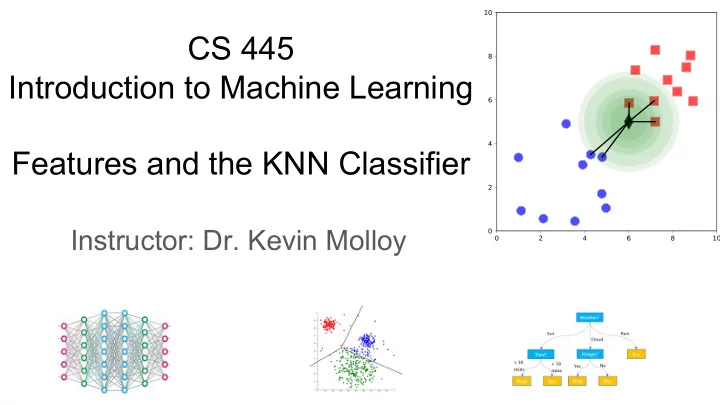

CS 445 Introduction to Machine Learning Features and the KNN Classifier Instructor: Dr. Kevin Molloy
Features If it walks like a duck, and quacks like a duck, it probably is a duck. Features describe the observation:
Decision Tree Architecture Idea : Identify the feature and the value of the feature (split point) that divides the data into 2 groups that minimizes the weighted "impurity" of each group. Repeat this process on each leaf until happy. Observation: The model splits the data one feature at a time.
Distance (dissimilarity) between observations Define a method to measure the distance between two observations. This distance incorporates a set of the features into a single number (scalar). Idea : Small distances between observations imply similar class labels. Euclidean Distance and Nearest Point Classifier 1. Compute distance from new point p point Dist to p (the black diamond) and the training 1 2.45 set. 2 1.30 3 0.99 … … n 8.23
Distance (dissimilarity) between observations Define a method to measure the distance between two observations. This distance incorporates all the features at once. Idea : Small distances between observations imply similar class labels. Euclidean Distance and Nearest Point Classifier 1. Compute distance from new point p point Dist to p (the black diamond) and the training 1 2.45 set. 2 1.30 3 0.99 2. Identify the nearest point and assign … … its label to point p n 8.23
Euclidean Distance and Nearest Point Classifier Voronoi Diagram ( https://en.wikipedia.org/wiki/Voronoi_diagram) Create regions such that for any point p in the same region, their closest data point (the dots) are the same.
Euclidean Distance and Nearest Point Classifier Voronoi Diagram ( https://en.wikipedia.org/wiki/Voronoi_diagram) Create regions such that for any point p in the same region, their closest data point (the dots) are the same. Outlier – an object different than most other objects of the same type
Euclidean Distance and K-Nearest Point Classifier Idea: Increase the number of neighbors ( k ) and take a majority vote. Algorithm k = number of nearest neighbors D = training examples and labels (x, y) z = point (vector of points) to classify Compute dist( x i , z ) (distance between z and every training data point x i ) D z = set of k closest examples to z ( D z ⊆ D) z predict = argmin ∑ (# ! ,% ! )∈( " 𝐽(𝑤 == 𝑧 ) ) !
Decision Boundaries: Boundaries are perpendicular (orthogonal) to the feature being split. What do the KNN decision boundaries look like?
Will I go Outside to play Today? Let's try and build a model and predict. Feature Values Weather Sunny, Rainy, Overcast Temperature Hot, Mild, Cold The label/class will be to predict if the child will play outside (Yes/No). Issues?
Computing Distances How to compute a distance between Sunny, Rainy, and Overcast?
Computing Distances How to compute a distance between Sunny, Rainy, and Overcast? Is Dist(Sunny, Cloudy) == Dist(Sunny, Rainy) ?
Computing Distances How to compute a distance between Sunny, Rainy, and Overcast? Is Dist(Sunny, Cloudy) == Dist(Sunny, Rainy) ? Difference between ordinal and nominal datatypes (see IDD section 2.1.2)
Smallest Distance means Most Similar? Dataset Who is the most similar person to Age Salary this in the dataset (right)? 23 56K 35 75K Age = 39 Salary = 75,750 55 76K
Smallest Distance means Most Similar? Dataset Who is the most similar person to Age Salary this in the dataset (right)? 23 56K 35 75K Age = 39 Salary = 75,750 55 76K
Smallest Distance means Most Similar? Dataset Who is the most similar person to Age Salary this in the dataset (right)? 23 56K 35 75K p = (Age = 39 , Salary = 75,750) 55 76K Age Salary Distance to point p 39 − 23 ! + 75750 − 56000 ! ≈ 19,750 23 56K However, the Euclidian 39 − 35 ! + 75750 − 75000 ! ≈ 750 35 75K distances say otherwise. 39 − 55 ! + 75750 − 76000 ! ≈ 251 55 76K
Normalization Dataset Idea : Make the range of all features the same. Age Salary Start with age. Min value: 23, max value: 55 23 56K 35 75K p = (Age = 39 , Salary = 75,750) # !,$ ,-./(0 ! ) + = 55 76K 𝑦 ),* -12 0 ! ,-./(0 ! ) Age Salary Dist Age normalized Salary Dist (with (orig) Normalized normalized values) 19,750 23 56K (23 – 23)/(55-23) = 0 (56k –56k)/(76k – 56k) = 0 750 35 75K (35-23)(55-23) = 0.375 (75k – 56k)/(76k-56k) = 0.95 251 55 76K (55-23)/(55-23) = 1.0 (76k-56k)/(76k-56k) = 1
Normalization Dataset Idea : Make the range of all features the same. Age Salary Start with age. Min value: 23, max value: 55 23 56K 35 75K p = (Age = 39 , Salary = 75,750) # !,$ ,-./(0 ! ) + = 55 76K 𝑦 ),* -12 0 ! ,-./(0 ! ) Age Salary Dist Age normalized Salary Dist (with (orig) Normalized normalized values) 19,750 23 56K (23 – 23)/(55-23) = 0 (56k –56k)/(76k – 56k) = 0 1.1 750 35 75K (35-23)(55-23) = 0.375 (75k – 56k)/(76k-56k) = 0.95 0.13 251 55 76K (55-23)/(55-23) = 1.0 (76k-56k)/(76k-56k) = 1 0.50
Recommend
More recommend